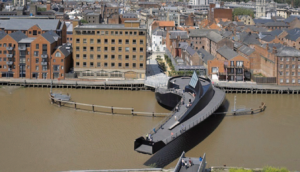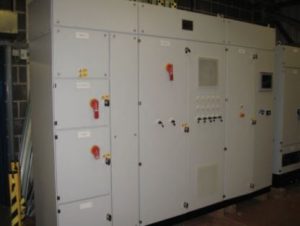This innovative swing bridge over the River Hull is believed to be the first bridge in the world that allows pedestrians the unique experience of riding it while in motion.

Its black steel appearance and distinct robust form make it a memorable landmark that reflects Hull’s industrial and maritime heritage. With a 57m span, the 1,000t pedestrian and cycle swing bridge provides a new route that connects the city centre and Old Town Conservation Area to The Deep on the east bank of the River Hull.
The client’s brief was for a bridge that would become an iconic landmark, increase connectivity across the city, unlock regeneration potential and increase the use of the river frontage. The brief also required navigation clearances to be maintained at all times for small boats and the bridge to be able to open for larger vessels.
The bridge’s sweeping form creates a choice of two curving pedestrian routes – one gently sloping, the other stepped. The circular geometry of the bridge’s hub means the walkway is always in contact with the river’s west bank as it swings open, allowing people to walk on and off as it moves.
The structure can carry up to 1,000 people while opening and up to 4,000 people when closed.
It is supported vertically on a central pintle and six single and four double wheel assemblies running on a flat circular track, secured to a drum supported on 1.6m diameter 30m long piles. Three electric bevel gear units drive the bridge which pivots around a central slew bearing.
Drives and Automation supplied the control system hardware and integration expertise, while London based McDowell and Benedetti were architects on the project. Barnsley based engineering house Qualter Hall provided the steel fabrication and assembly, lighting scheme and project management.
Technical Details
• Allen Bradley Powerflex Inverters
• Leroy Somer A.C Braked Motors
• Siemens Softstarts
• Allen Bradley Compactlogix PLC with Point I/O
• Panelview HMI
• Form 4 Distribution board c/w Socomec changeover switches
• Form 4 Motor Control Centre
• Cavotec Radio Remote Control System
• Elpro Wireless I/O
Qualter Hall chose Drives and Automation to provide the system integration for this project. The package included the supply of marine motors, encoders, motor control centres, wireless control systems
with GSM modem, electrical design, software and commissioning.

Drives and Automation supplied a Form 4 distribution board to house the supplies to the MCC. A 6-pole changeover switch was provided to allow the bridge to operate using the standard grid supply or
an emergency generator. The generator supply can be coupled to the distribution board using VEAM connectors designed for the ultimate in safety and reliability under severe operating conditions.
The Form 4 MCC houses; control supplies, PLC/HMI section, inverter section and hydraulic power pack sections.
The final client specified Allen Bradley equipment, the control system was therefore based on a Compactlogix PLC with Panelview HMI and Powerflex inverters. DnA provided the software integration, loadsharing of the inverter drives, PLC and HMI hardware, complete with a comprehensive maintenance manual.
A Pilz multi system was chosen for the safety interlocking and monitoring, which was a crucial requirement in this very public and high profile application.
The safety interlocking and control was unusual on the project due to the rotation of the bridge and the fact that there was no cabling between shores. Therefore the safety interlocking system and solenoid
control on the opposite banks of the river had to operate wirelessly. This was solved by using an Elpro wireless I/O transmitter and receiver.
Problem Solved
• Electrical motors provide environmentally friendly, oil free system compared to traditional hydraulics
• Wireless solution eliminates need to wire over impractical cable routes
• Innovative design achieved using state of the art hardware Solution
• Integrated PLC/HMI design
• Modern SIL safety rated equipment
• Comprehensive diagnostics and fault reporting (local and remote)
• Comprehensive Documentation Provided
Benefits
• Reliability
• Remote diagnostics minimises requirements to attend site
• Easy To Maintain and Fault Find
